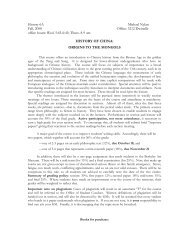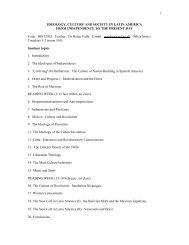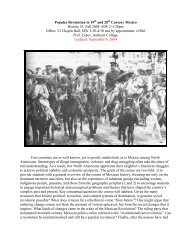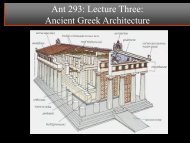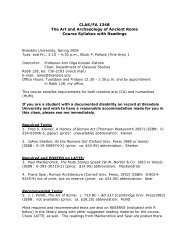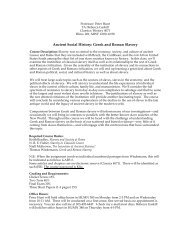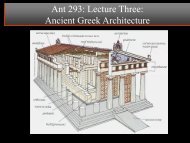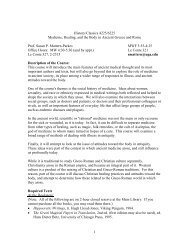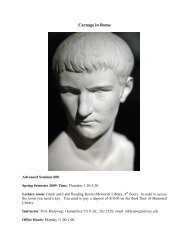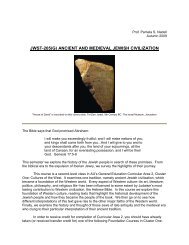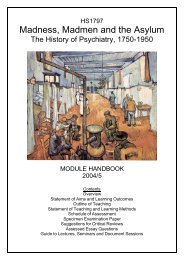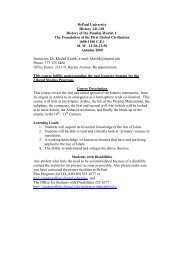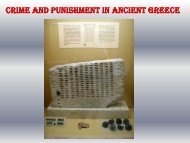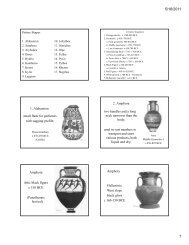Quest For Historical Troy
Quest For Historical Troy
Quest For Historical Troy
- No tags were found...
Create successful ePaper yourself
Turn your PDF publications into a flip-book with our unique Google optimized e-Paper software.
“I HAVE GAZED UPON THE FACE OF AGAMEMNON”:THE QUEST FOR THE HISTORICAL TROY
At the entrance to the First Cemetery in Athens
Heinrich Schliemann’s Mausoleum in the First Cemetery
“To Schliemann The Hero”:Heinrich Schliemann places himself within the contextof Ancient Greek History and Myth on his Mausoleum
Aeneas picturedescaping from aburning <strong>Troy</strong> inLudwig Jerrer’sUniversal History
•Schliemann born in 1822 innortheastern Germany•His mother died when he wasyoung while his Lutheranminister father was suspendedfrom his parish post•A master self-taught linguist, hemade a fortune as a merchant inthe California Gold Rush and theCrimean War•He retired in 1864 to pursuefull-time the passion he claimedhad been instilled in him as ayoung boy: proving the truth ofthe stories of Homer
Schliemann digs his infamous trench at <strong>Troy</strong>
The“TreasureOf Priam”
TheUniversity ofCincinnatiarchaeologistCarl Blegeninitiated anew project at<strong>Troy</strong> in 1932
Stratigraphy capturing the different levels at <strong>Troy</strong>
The remains of the Southern Gate of <strong>Troy</strong> VI
The sloping walls of <strong>Troy</strong> VI
The remains of the temple of the goddess Athena at <strong>Troy</strong>
Manfred Korfmann led the Troia Projekt from 1988-2005
The <strong>Troy</strong> Project identified this as afortification ditch in the lower town in 1993
A representation of the shoreline at <strong>Troy</strong> in the Late Bronze Age
A computer-generated model of <strong>Troy</strong> VI from the <strong>Troy</strong> Project
HeinrichSchliemann at theLion’s Gate atMycenae
The Schliemanns began their dig at Mycenae in 1876
Grave Circle A at Mycenae
<strong>For</strong> Schliemann andBritish PrimeMinister WilliamGladstone alike,these bones andteeth suggested aclear likeness ofAgamemnon asdescribed by Homer
“Gold-Rich” Mycenae: Artifacts from the shaft grave
More loot from the Schliemann dig at Mycenae
The tholos tomb known as “The Treasury Of Atreus” in 1834
The remains of the Bronze Age Palace of Tiryns
Odysseus Found?: The latest theory
Lord Byron on his death-bed in 1823
Near the summit of Mount Aetos on Ithaca:The spot identified by Schliemann in 1868 as Odysseus’ palace
A bust ofOdysseus standsin the villagesquare of Stavros
The Pilikata Ridge on Northern Ithaca:Identified by some archaeologists as a possible site of a Bronze Age palace
The site of where the Polis Cave was located
An aerialshot oftoday’sIthaca
Schliemann dugs down into the ruins of the Palio Navarino at Pylos
Tholos tombexcavated atMalthi in 1938by MattiasValmin for theSwedishMesseniaExpedition
Carl Blegen’s first trench at Pylos in 1939 discovers the archive room
Digging at the Palace at Pylos in 1939
An archaeological artist’s reconstruction of the Palace of Nestor
Today’s Palace of Nestor under a corrugated steel roof
Spyridon Marinatos:Greece’s most famousarchaeologist and thepost-WW II eracollaborator withBlegen at Pylos
The grave at Voidokoilia that Marinatos associatedwith one of the sons of King Nestor
Scientistswith PRAPdrill at thesite of theancientPylos port
The prehistoric topography of the port of Pylos reconstructed
A Linear B tablet from Pylos
Michael Ventris:The British Architectwho decipheredLinear B
Another Pylos Tablet
<strong>For</strong>eign Women Mentioned In The Pylos Tablets• One group came from the island of Kythera• Another came from A-swi-ja (Asia), the region of Anatoliareferred to in Hittite tablets as Assuwa and later to be known asLydia• Some women came from the Mycenaean colony of Miletus onthe west coast of Anatolia• Another group came from Knidos, 100 kilometers to the north ofMiletus• Yet another group came from Lemnos, a large island in thenorth-east Aegean• Women from the island of Lesbos are also mentioned
The Mycenae cistern built down into the bed-rock
The layers of <strong>Troy</strong> over a 3,000-year span
The remains of the Ulu Burun ship wreck on display in Bodrum, Turkey
The remains at Hattusa
Pharaonic spin-doctoring at the Ramesseum:The Battle of Kadesh (1274 BCE) remembered and embellished
The Luwian seal found at <strong>Troy</strong> in 1995
A Hittitetablet fromthe royalarchive atHattusa
TROY AND THE HITTITE RECORDSThe first likely mention of <strong>Troy</strong> comes from the record of amilitary expedition conducted by the Hittite King Tudhaliya Iagainst the “Confederacy of Assuwa” sometime in the late15 th centuryListed among the many towns and cities comprising theconfederacy are Wilusiya and Taruisa
MANAPA-TARHUNDA LETTERMost likely dates to the reign of the Hittite King Muwatalli II (1295-1272 BCE)Manapa-Tarhunda, the king of the Seha River Land, also innorthwest Anatolia and south of Assuwa, has attacked, possiblywith Muwatalli’s blessing, a rebel Hittite chieftain namedPiyamaradu, who has made himself overlord of WilusaThe result has been as resounding defeat for Manapa-TarhundaAs Manapa’s letter makes clear, Piyamaradu was not contentmerely to ward off the attack but apparently removed Manapafrom power and placed the Seha River Land in the hands of hisson-in-law, the ruler of MillawandaFurthermore, Piyamaradu followed up this coup with an invasion ofthe Land of Lazpa, a dependency of the Seha River LandManapa is excusing him from taking part in the Hittite reprisalsagainst Piyamaradu
ALAKSANDU TREATYA bilateral treaty between the Hittites and Wilusa specifying theconditions of the vassal relationship.The treaty highlights the history of the relationship through Hittiteeyes:1) The subjugation of Wilusa by Hattusa before 1660 BCE2) No (effective) secession of Wilusa from Hattusa between thisdate and the reign of Tudhalija I (c. 1420-1400), when war waswaged against Arzawa3) No alliance between Wilusa and Arzawa, which was hostile tothe Hittites, in the time of Suppiluliuma I (c. 1355-1320)4) No Wilusan involvement in the war between Arzawa and MursiliII (c. 131801290)5) Conclusion of a vassal treaty between Alaksandu of Wilusa andMuwattalili II (c. 1290-1272)
THE AHHIYAWA CONTROVERSYDoes Ahhiya equal Achaean (ie. Mycenaean)?This debate has raged in Anatolian Studies since the 1920s.There has been a seemingly growing academic consensus inrecent decades that this is indeed the case.If the Ahhiyawans are the Mycenaeans, the best place to searchfor the “Trojan War” may be in the Hittite Archives.
ATTARSSIYAThe first written evidence for Ahhiyawan-Mycenaeaninvolvement in western Anatolia introduces us to a “Man ofAhhiya” called Attarssiya, one of only two Ahhiyawan peoplewho are named in our surviving documentsAttarssiya was present on the Anatolian mainland with around1400 with a small army of infantry and approximately onehundred chariots
TAWAGALAWA LETTERAddressed by Hattusili III (c. 1265-1240) to the king of AhhijawaHattusili complains cautiously that the latter does not stop thedepredations of Pijamaradu throughout western Asia Minorfrom Wilusa and Lazba to MillawandaThe letter mixes pleas and threatsThe last sentence says that the king of Ahhijawa should write toPijamaradu as follows: “The king of Hatti has persuaded me,in that matter of Wilusa(?), over which we quarreled, and heand I have become friends . [ . . .] a war would not be goodfor us.”
MILLAWANDA LETTERDates probably from early in the reign of Hattusili’s son andsuccessor Tudhaliya IV (1237-1209)Millawanda is now back in the Hittite sphere of influenceIn part of the letter Tudhaliya instructs the addressee (whosename is not known) regarding the proper boundary ofMillawanda.We learn of a Hittite expedition sent against Millawanda in thethird year of King Mursil II’s reign, because it had tried to joinforces with the king of Ahhiya.
RECENTLY DISCOVERED THEBES TABLETSBetween 1993 and 1995, more than 250 tablets and fragments oftablets were found in Thebes.This represented the third largest find of Linear B tablets inmainland Greece.The tablets belong to a palace archive of Kadmeia, destroyed ina fire circa 1200 BCE.Some scholars suggested this added credence to the theorythat Thebes might have been the center of Ahhijawan power
2003 Announcement In <strong>Troy</strong>The Anatolian specialist Professor Frank Starke was able topresent the first cuneiform letter in Hittite to be sent not fromeast to west, from Hattusa to Ahhijawa, but from west toeast.The sender of this letter was a king of Ahhijawa, and therecipient the Great King of the Hittites.Paleographic evidence dates the letter to the 13 th C. BCE.The letter deals with the matter of the islands which originallybelonged to Assuwa. The islands in question are most likelyLemnos, Imbros, and/or Samothrace.The king of Ahhijawa argues from history; he explains that aforebear of his had given his daughter in marriage to thethen king of Assuwa.That forebear is mentioned: Kadmos.
Ingres’s deification of Homer
TheCatalogueOf Shipsfrom theIliad
Homer And The Epic TraditionSherratt and others have argued that at least three differentlayers of epic material are included in the Iliad.The diverse and anachronistic weapons described by Homerare used as evidence for this thesis.The long spears, body shields, and boars’ tusks helmutsbelong to the late 15 th or early 14 th centuries.A second layer including shield bosses, throwing spears andhorned helmets and belong to the ear of Mycenaean declineand collapse and the first century or so of the ensuing DarkAge (c. 1200-1000 BCE)The third layer features the circular shield and crested helmet,and would be roughly contemporaneous with Homer himself(9 th and 8 th centuries).
In the 1930s, theAmerican scholar MilmanParry conducted a seriesof studies of South Slavicoral epic poetry to betterunderstand Homericpoetry through analogy



